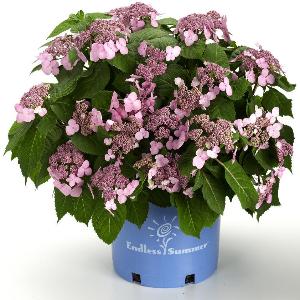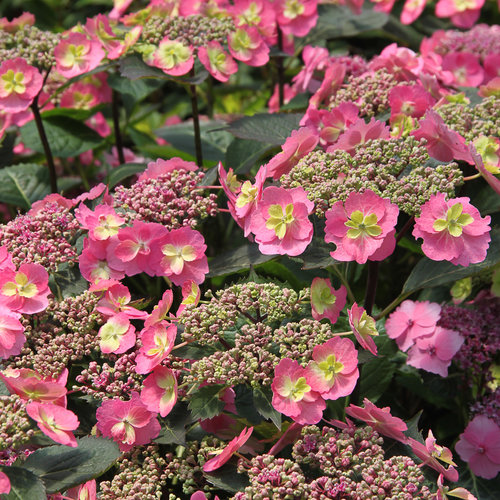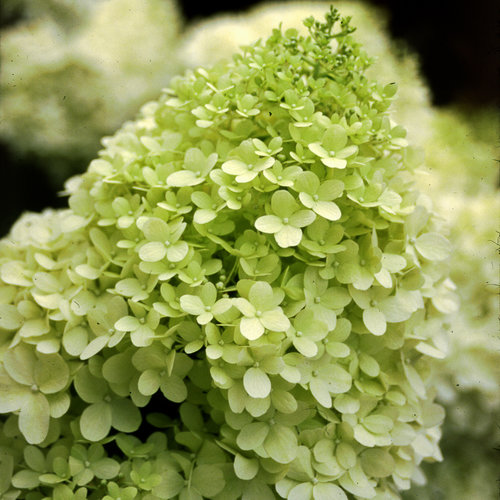Oh hydrangeas! why do you vex so many home gardeners , tormenting them with pictures of your voluptuous mop-head blooms and elegant lace -caps, only to stubbornly remain an awkward green foliage plant all season? Well, I could write a book, and a very long one , on the various types of hydrangeas, why and when they bloom, and how to prune them etc, but I will stiffle all the science and give you the low down and dirty easy lesson on how to chose the right ones to make your garden spectacular.
First, let’s tackle the blooming issue. Older hydrangeas( pre 1998) of the macrophylla persuasion that have both mop head and lace-cap flowers bloom ONLY on woody growth they produced in the last growing season . This is called, surprisingly , “old wood”. Plants that bloom on old wood will not bloom if you prune them in the spring as you are essentially cutting off the flowers even if you can’t see them, or if we have a very sever winter or even a late frost after a warm up in the spring you will loose the flower buds to cold. This makes them dicey choices for specimen plants. It is nothing you did, it is just the nature of the plant.
In the late 1990’s breeding began to develop hydrangea macrophylla cultivars that bloom on old wood AND new wood, meaning growth they produce in the current year. The big bad botanical word for this is remontant . The first of these remontant , or re-blooming hydrangeas was Endless Summer and there was a great rush to plant these en masse . In my opinion they are duds and barely bloom at all on new wood and I have heard many frustrated gardeners from these parts who thought they found the Holy Grail of hydrangeas express the same disappointment. Since then, the Endless Summer line has expanded and now includes a few that actually do bloom well on new wood.
In the ensuing years many other plant breeders have flooded the market with re-blooming hydrangeas , so now your choices are many and it can certainly be overwhelming.
My favorite so far? The third introduction of the Endless Summer line called “Twist and Shout”. This is a lace-cap with just stunningly beautiful ,deep rich color changes. It blooms all season long , and as a bonus has striking red stems. Plant one!!!!
The other lines and names of rebloomers you should look for are
All Summer Beauty:What Endless Summer wishes it was, a true blue re-bloomer that goes all season long and is reported to do well even into upstate Maine where it is certainly cold and has a short growing season. A true victim of good vs. bad marketing in the nursery industry.
Blushing Bride– also part of the Endless Summer line, that reliably produces a bounty of white fading to blush pink mop-heads all season long.
The “Let’s Dance” series from Proven Winners- many color variations on the traditional blue or pink typical of big leaf hydrangeas, and readily available at local garden centers
Also from Proven Winners “Tuff Stuff”– This is hydrangea serrata, or Mountain hydrangea , and is very long blooming reddish pink lace cap . It will bloom right up until frost. 
The “Forever and Ever “ series, also boasts reliable re-bloomers, and has great color variety. Just be aware that a few of them are quite small (2-3 ft) and some are only hardy to zone 6. ALWAYS read the plant label!
With any of the above hydrangeas , grow in well amended soil in morning sun and afternoon shade with plenty of water.
Pannicle hydrangeas, like Hydrangea grandifora ( often grown in tree form) or hydrangea paniculata “Limelight” sport long conical blooms that appear white or chartruese and fade to mauve. They can grow in full sun and bloom ONLY on NEW wood , so can be pruned in the spring. There are smaller versions, like “Little Lime” that will fit better in smaller spaces so you can forgo any pruning. .
.
. 
As a quick aside, you should stick to buying plants that when full grown still fit your space. You should never really have to prune a hydrangea other than to take off spent blooms unless you planted the wrong one to begin with. Just sayin’ 😉
Smooth hydrangeas, or Hydrangea arborescens , bloom on NEW wood and can be pruned quite drastically f you desire. The most common one is ‘Annabelle’ which is a white mop-head , but some newer introductions, such as “ Bella Anna ‘ are pink .  These are easy to care for and very hardy.
These are easy to care for and very hardy.
Hydrangea quercifolia, or oak leaf hydrangea is another beauty for a shadier area. This hydrangea blooms on old wood but is generally pretty reliable . The leaf color is incredible in the fall ( either red or burgandy) and my favorite is called “Snow Queen” ( photo: White Flower Farm)
So, to sum up and keep it easy , some rules
1. If you have an older hydrangea that does not bloom every year , or a new one that is supposed to re-bloom and doesn’t, shovel prune that darn thing and start over
2. Head to a decent garden center and ask for any of the newer cultivars that RELIABLY re-bloom and that you like the flower shape and color of
3. Plant in well amended soil in morning sun/afternoon shade for hydrangea macrophylla and serrata and quercifolia, part shade to full sun for paniculata types and water well.
4.Read the plant label once, then read it again, then measure your growing space, then read plant label a third time. Plant hydrangea in a space that will accomadate it when it is full grown and then there will be no issues and questions about pruning
5. Enjoy your BLOOMING hydrangea!
This Post is the first of a new feature here called Down and Dirty Lessons for the Home Gardener. You can access any post in this category by clicking on the “Down and Dirty” link in CATEGORIES to the right. The lessons will be succint and brief outlines or directions about a plant, garden technique, or design dilemma with as few big words and confusing concepts as possible, just the least and BEST information you need to make something work. I hope you ,my dear reader who may be suffering from information overload or may be confused about a garden issue , will benefit from them .If you have any topic you would like to cover PLEASE let me know!